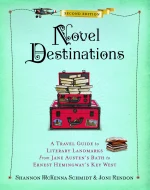One hundred and six. That is the number of stops we’ve made during twenty months of continuous travel. We move so often that it has become second nature. These days, getting to a new destination isn’t much different than commuting to work. We experience no anxiety, or make special plans. We don’t even really need to give it a lot of thought. We just pack up and go. That is, as long as we’re driving the RV.
Our 107th stop is something else entirely. Shortly we’ll be leaving the RV behind and taking a flight to Belize. From there we’ll spend two months backpacking across Northern Central America. This is a completely new form of travel for us and required a bit more preparation. This is how we got ready.
Travel Bags
We didn’t absolutely need new luggage for the kind of travel we envision, but for ultra-mobility a backpack is hard to beat. The variety of bags available surprised and overwhelmed us, though. Complicating matters is that many retailers only carry certain brands, making comparison shopping a bit of pain. We also discovered that most backpacks are designed with the hiker, not the traveler, in mind. Travelers have special needs, and most bags fell short somehow.
Here’s what we were looking for, and ultimately what we got:
Think small, light and ultra-portable
The most common mistake travelers make is to pack for every possible contingency. The problem with large bags is not only that they’re heavy (or impossible) to carry, they also increase the likelihood you’ll be separated from your gear. Yet paying to check luggage is really the least of your worries when traveling to developing countries. Keeping a hand on your bags when riding local transportation can mean the difference between arriving with your stuff and without it.
We looked for backpacks with between 30 and 40 liters of storage capacity (1 to 1.5 cubic feet). That’s small enough to fit under an airplane seat or just about anywhere else we go.
Can I access the bottom without unpacking?
I’m sure there is a good reason most hiking packs are designed to only open at the top, but it isn’t obvious to anyone who wants to get something from the bottom without unpacking the entire bag. We looked for backpacks with zippers along their entire length. This requirement alone disqualified dozens of contenders.
How does it fit?
Good backpacks distribute weight evenly on your shoulders, back and hips. Some are more adjustable than others, but one size does not fit all. Get fitted by a knowledgeable retailer and try on several packs loaded with weights to get the most comfortable bag for you.
Shannon had difficulty with many of the “unisex” bags and found lines with dedicated women’s sizes to work best. Unfortunately, they seemed somewhat rare so her choices were more limited.
Tented or Flat?
Many new packs are “tented” so they mostly stay off the length of your back to help keep you cool. This looks like a fantastic design for hikers but it also adds to the bulkiness of the bag, which is something we didn’t want. We also worried that the bowed frame might be more susceptible to damage from the repeated cramming common for travel bags.
Rain Covers
We’ll be carrying a fair amount of electronics so having a raincoat for our bags seemed sensible. You can buy covers separately, so their absence wouldn’t necessarily disqualify an otherwise acceptable backpack. But a properly fitting cover with its own easily accessible pouch is certainly a plus.
And the winner is . . .
REI’s 40-liter Lookout pack checked all the boxes on our list. They even had a women’s size that helped Shannon get the kind of fit she couldn’t with most of the “unisex” styles. Best of all, it was one of the least expensive packs we investigated.
Gear Security
We’ve accepted the fact that determined thieves will be able to take whatever they want from us. No amount of countermeasures can prevent it. With that in mind, the few things we do are really designed to hinder the casual, hurried, or lazy criminal. We assume that covers most of them.
Bag locks
We invested $5 in small luggage locks. We’re under no illusions that these dainty little locks will protect the contents of our bags. What we expect them to do, though, is keep inquisitive service staff from simply opening a zipper and helping themselves. Cutting a lock or slashing a backpack requires a higher level of commitment than a typical crime of opportunity.
Bike chain
We invested another $5 in a lightweight bike chain to secure our bags while we’re away. The security provided here is similar to our bag locks. It will take a bit more effort for someone to walk off with our bags so hopefully they’ll choose easier targets.
PacSafe
PacSafe is a wire-mesh security system that is more robust than our simple bag lock and chain scheme. At roughly 15 times the cost (for two bags) we’re not sure it provides 15 times the protection.
Travel Vaccines
Before any trip overseas, stop at the Center for Disease Control’s “Traveler’s Health” page first. There you’ll find tons of information about which diseases are prevalent at your travel destination and about recommended prevention measures. Make sure to do this research early in your planning as some vaccines require multiple inoculations or a certain amount of time to become effective.
Communication
Staying in touch while on the road isn’t a luxury for us, it is an absolute necessity. We’ll be trying to run a freelance writing business out of our backpacks. We’ll have deadlines to meet and possible telephone interviews to conduct.
Unlocked Phones
It’s possible to get phones that are capable of connecting to local cell service by swapping SIM cards. This is a good option for making cheap local calls, but calling internationally can still be pretty expensive. Unfortunately the Verizon phones that have worked so well for us in the States don’t use SIM cards. Instead of getting new phones for the trip, we’re planning to try another option.
Skype
Skype is a telephone service that allows you to make calls over the internet. When Skype first came out its usefulness was limited. You could only make calls from a computer to a computer, which worked well for geeks trying to save a couple bucks but wasn’t really a viable alternative for most of us. Now Skype allows calls to any telephone. And because “smart phones” are really just computers, you can now make Skype calls from your cell phone too.
With Skype we can make calls whenever we have a wifi connection, which we assume will be most of the time. A plan allowing us to make unlimited calls to the U.S. from anywhere in the world costs just $2.99 per month. The price of local calls depends on location. We’ll pay as little as $0.15 per minute for local calls in Guatemala and as much as $0.37 per minute in Honduras; a downright bargain compared with the $1.99-$2.89 per minute “roaming” rate charged by Verizon.
Internet
The world is pretty well wired and we expect to find wifi in most hotels and hostels. In a pinch, we’ll make use of internet cafes. If neither of these options gives us the access we need, we’ll pick up an aircard from the regional telephone provider. One way or another, we’ll make it work. We have to.
Preparing for an Extended Backpacking Excursion (Part II)
Next week we’ll discuss our approach to managing money, travel insurance and more.
























I’m looking for a new backpack (did you see mine in Antigua?? it’s a free, flimsy, old and battered one from Sierra Club) … so I really appreciate your thoughtful and concise overview … you guys were SO fun to talk to & meet!!! Kismet!!! (and thanks for the shout-out on Twitter … you beat me to it by a mile!!)
LikeLike
Hi Betty,
It was wonderful to meet you, in Antigua Guatemala of all places. I absolutely love when our real and virtual worlds collide like that. What you’re doing is so interesting and so inspiring. Maybe we can figure out a way to coordinate in some way in the future.
Happy travels,
Brian
LikeLike
Great post and a wealth of information! Thanks for sharing!
LikeLike
Hey, I’m passing on the 7×7 link award to you – a dubious honour as it comes with quite a set of rules, but feel free to ignore them and just take it as a compliment. You can see what I said about your blog here: http://indiaphare.wordpress.com/2012/02/01/fall-seven-times-and-stand-up-eight/
LikeLike
I think you guys are great for sharing your thinking and writing talents. Thank you very much.
Belize – I hope you’re both fairly immune to bites and mosquitoes or love the smell and feel of DEET. My daughter (age 30), who has spent much time outdoors, visits Belize a couple weeks a year and despite best efforts gets bit so much as to need a sedative at times to endure the visits. As with most unique and beautiful aspects of life, some costs with the gains. Hoping it goes really well for you!
LikeLike
I find my Blackwolf brand backpack to be spectacular! It’s an Australian brand and the only place I’ve seen it available (so far) is Australia and the only people I’ve seen with them are Australians, but I’m a very petite (5’5″, 110-115 pounds) and I love my pack. They fit women really well. So if you are shopping from Australia, I highly recommend it! I had to get a 65 litre pack as well (fairly large for someone my size) because I’m covering so many seasons over the course of my year traveling (I’ve already gone from 6 degrees celcius to 27 degrees celcius and it’s only been 3 weeks) so I actually do have to pack lots of layers for all possible contingencies. A bit annoying, but the pack fits so well I don’t have a sore back when I have to walk for 3-4 km’s with it chockers full.
I guess my main piece of advice that you left out would be to ask the staff to load the bag full of really heavy stuff when you try it on so you really know how it feels at maximum capacity.
Happy Travels!
LikeLike
Thanks for the tips.
We probably will need larger packs too once we plan to hit multiple seasons. For the time being, we’re mostly planning couple month excursions to escape the U.S. winters (see today’s post, for example.) But even in the U.S. we can have temperature changes from 6-27 celsius and greater in a single day (morning to night) in places like Phoenix. It’s kind of crazy. We were also a bit surprised at the temperature change we experienced moving into the highlands of Guatemala from the low lands. Best to be prepared.
We really want to get to Australia, so maybe we’ll go pack shopping on our eventual RTW trip when we land there.
See you out there,
Brian
LikeLike
Yeah, I was in Tallinn, Estonia the other week and it went from 20 one day to 6 the next to 16 the next. With wind coming from the Baltic Sea. Frankly, it was a little bit ridiculous. I’m stuck carrying around cold weather gear for the next 4 months, but it’s good gear and cheaper than buying it again once I get down to North Africa/Middle East/Persia for the winter. You’d think the weather would learn to cooperate 😛
When you guys make it to Australia let me know. If I’m back home I’d be happy to play host, otherwise I’m glad to give you lots of information and tips about Australia!
LikeLike
Always love to meet locals and fellow travelers. We’ll definitely look you up.
LikeLike
Been meaning to thankyou for your constant support on my blog, cheers
LikeLike